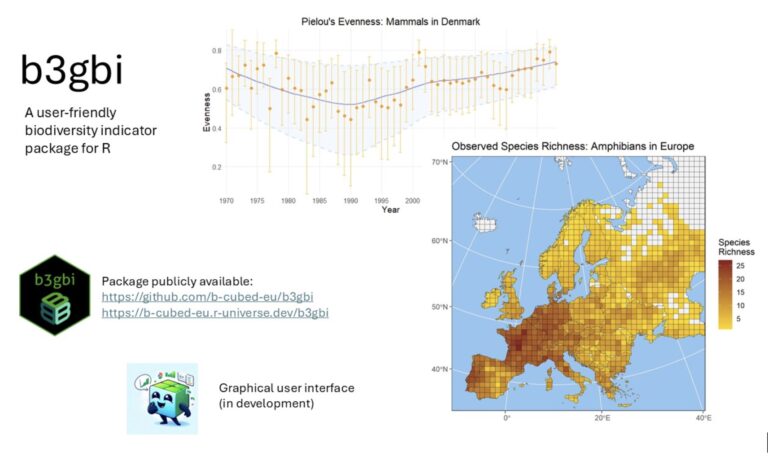Our result
Result description
The b3gbi (B-cubed: General Biodiversity Indicators) R package (https://github.com/b-cubed-eu/b3gbi) offers a robust and user-friendly platform for analysing biodiversity trends and spatial patterns using GBIF occurrence data. Compatible with various grid reference systems like the EEARG, MGRS, and QDGC, b3gbi supports flexible data integration.
With b3gbi, users can calculate a wide array of biodiversity indicators, including species richness, evenness, rarity, Hill-Shannon diversity, Hill-Simpson diversity, taxonomic distinctness, and occupancy turnover. It also enables analyses of species occurrences, ranges, total occurrences, and occurrence density across time and space.
The package simplifies the creation of customized, publication-ready figures, accommodating users with minimal R knowledge. Advanced users can leverage integration with rnaturalearth, ggplot, and dubicube for enhanced mapping, plotting, and uncertainty analysis.
Designed for both policymakers and researchers, b3gbi ensures ease of use while providing the analytical power needed to support data-driven conservation efforts.
Addressing target audiences and expressing needs
- Collaboration
We encourage community contributions to b3gbi and welcome collaborations that align with the package’s core goals. We aim to promote accessibility of biodiversity data and indicators by providing user-friendly open source tools and standardised workflows. The b3gbi package (https://github.com/b-cubed-eu/b3gbi) already includes many common biodiversity indicators but is designed to be extensible so that collaborators can contribute to its functionality and relevance.
- EU and Member State Policy-makers
- International Organisations (ex. OECD, FAO, UN, etc.)
- Research and Technology Organisations
R&D, Technology and Innovation aspects
The package is fully functional and working, and publicly available on Github and R Universe. It is planned to be deployed soon on the cloud and on CRAN.
Inform biodiversity research and policy with b3gbi. Analyze GBIF data cubes using common biodiversity indicators (richness, evenness, rarity, taxonomic distinctness, occupancy turnover, etc.) to understand biodiversity trends and spatial patterns, including responses to conservation actions, policies and environmental change.
Result submitted to Horizon Results platform by:
Instituut voor Natuur- en Bosonderzoek (INBO) Hoofdzetel, Belgium

